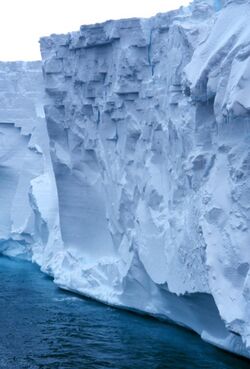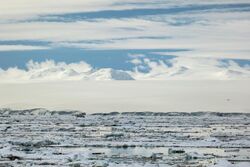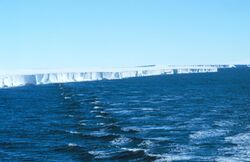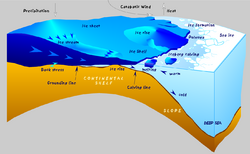Earth:Ice shelf
An ice shelf is a large floating platform of ice that forms where a glacier or ice sheet flows down to a coastline and onto the ocean surface. Ice shelves are found in Antarctica and the Arctic (Greenland, Northern Canada, and the Russian Arctic). The boundary between the floating ice shelf and the anchor ice (resting on bedrock) that feeds it is the grounding line. The thickness of ice shelves can range from about 100 m (330 ft) to 1,000 m (3,300 ft). The world's largest ice shelves are the Ross Ice Shelf and the Filchner-Ronne Ice Shelf in Antarctica. When a large piece of an ice shelf breaks off, this can lead to the formation of an iceberg (which is a piece of freshwater ice more than 15 m long).[1][2] This process is also called ice calving.
The movement of ice shelves is principally driven by gravity-induced pressure from the grounded ice.[3] That flow continually moves ice from the grounding line to the seaward front of the shelf. Typically, a shelf front will extend forward for years or decades between major calving events (calving is the sudden release and breaking away of a mass of ice from a glacier, iceberg, ice front, ice shelf, or crevasse).[4][5] Snow accumulation on the upper surface and melting from the lower surface are also important to the mass balance of an ice shelf. Ice may also accrete onto the underside of the shelf.
The effects of climate change are visible in the changes to the cryosphere, such as reduction in sea ice and ice sheets, and disruption of ice shelves. In the last several decades, glaciologists have observed consistent decreases in ice shelf extent through melt, calving, and complete disintegration of some shelves.[6] Well studied examples include disruptions of the Thwaites Ice Shelf, Larsen Ice Shelf, Filchner–Ronne Ice Shelf (all three in the Antarctic) and the disruption of the Ellesmere Ice Shelf in the Arctic.
Definition
An ice shelf is "a floating slab of ice originating from land of considerable thickness extending from the coast (usually of great horizontal extent with a very gently sloping surface), resulting from the flow of ice sheets, initially formed by the accumulation of snow, and often filling embayments in the coastline of an ice sheet."[7](p2234)
In contrast, sea ice is formed on water, is much thinner (typically less than 3 m (9.8 ft)), and forms throughout the Arctic Ocean. It is also found in the Southern Ocean around the continent of Antarctica.
The term captured ice shelf has been used for the ice over a subglacial lake, such as Lake Vostok.
Properties
Ice shelves are thick plates of ice, formed continuously by glaciers, that float atop an ocean. The shelves act as "brakes" for the glaciers. These shelves serve another important purpose—"they moderate the amount of melting that occurs on the glaciers' surfaces. Once their ice shelves are removed, the glaciers increase in speed due to meltwater percolation and/or a reduction of braking forces, and they may begin to dump more ice into the ocean than they gather as snow in their catchments. Glacier ice speed increases are already observed in Peninsula areas where ice shelves disintegrated in prior years."[8]
Height
The density contrast between glacial ice and liquid water means that at least 1/9 of the floating ice is above the ocean surface, depending on how much pressurized air is contained in the bubbles within the glacial ice, stemming from compressed snow. The formula for the denominators above is [math]\displaystyle{ 1/[(\rho_\text{seawater} - \rho_\text{glacial ice})/\rho_\text{seawater}] }[/math], density of cold seawater is about 1028 kg/m3 and that of glacial ice from about 850 kg/m3[9][10] to well below 920 kg/m3, the limit for very cold ice without bubbles.[11][12] The height of the shelf above the sea can be even larger, if there is much less dense firn and snow above the glacier ice.
By country or region
Antarctica
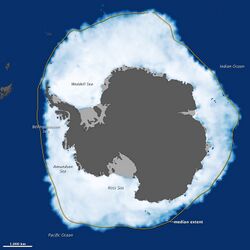
A large portion of the Antarctic coastline has ice shelves attached.[14] Their aggregate area is over 1,550,000 square kilometers (600,000 square miles).[15]
It has been found that of all the ice shelves on Earth, nearly all of them are in Antarctica.[16](p2234)
In steady state, about half of Antarctica's ice shelf mass is lost to basal melt and half is lost to calving, but the relative importance of each process varies significantly between ice shelves.[17][18] In recent decades, Antarctica's ice shelves have been out of balance, as they have lost more mass to basal melt and calving than has been replenished by the influx of new ice and snow.[19]
Ross Ice Shelf
Filchner–Ronne Ice Shelf
Arctic
Canada
All Canadian ice shelves are attached to Ellesmere Island and lie north of 82°N. Ice shelves that are still in existence are the Alfred Ernest Ice Shelf, Ward Hunt Ice Shelf, Milne Ice Shelf and Smith Ice Shelf. The M'Clintock Ice Shelf broke up from 1963 to 1966; the Ayles Ice Shelf broke up in 2005; and the Markham Ice Shelf broke up in 2008. The remaining ice shelves have also lost a significant amount of their area over time, with the Milne Ice Shelf being the last to be affected, with it breaking off in August 2020.
Russia
The Matusevich Ice Shelf was a 222 square kilometers (86 square miles) ice shelf located in Severnaya Zemlya being fed by some of the largest ice caps on October Revolution Island, the Karpinsky Ice Cap to the south and the Rusanov Ice Cap to the north.[20] In 2012 it ceased to exist.[21]
Impacts of climate change
The effects of climate change are visible in the changes to the cryosphere, such as reduction in sea ice and ice sheets, and disruption of ice shelves.
Disruption
In the last several decades, glaciologists have observed consistent decreases in ice shelf extent through melt, calving, and complete disintegration of some shelves.[6] Well studied examples include disruptions of the Thwaites Ice Shelf, Larsen Ice Shelf, Filchner–Ronne Ice Shelf (all three in the Antarctic) and the disruption of the Ellesmere Ice Shelf in the Arctic.
Disruption of Thwaites Ice Shelf
Disruption of Larsen Ice Shelf
Two sections of Antarctica's Larsen Ice Shelf broke apart into hundreds of unusually small fragments (hundreds of meters wide or less) in 1995 and 2002, Larsen C calved a huge ice island in 2017.[22]
Disruption of Larsen B Ice Shelf
Disruption of Filchner–Ronne Ice Shelf
Disruption of Ellesmere Ice Shelf (Arctic)
The Ellesmere ice shelf was reduced by 90% in the twentieth century, leaving the separate Alfred Ernest, Ayles, Milne, Ward Hunt, and Markham ice shelves. A 1986 survey of Canadian ice shelves found that 48 km2 (3.3 cubic kilometres) of ice calved from the Milne and Ayles ice shelves between 1959 and 1974.[23] The Ayles Ice Shelf calved entirely on August 13, 2005. The Ward Hunt Ice Shelf, the largest remaining section of thick (>10 meters (33 feet)) landfast sea ice along the northern coastline of Ellesmere Island, lost 600 square kilometers (230 square miles) of ice in a massive calving in 1961–1962.[24] It further decreased by 27% in thickness (13 meters (43 feet)) between 1967 and 1999.[25] In the summer of 2002, the Ward Ice Shelf experienced another major breakup,[26] and other instances of note happened in 2008 and 2010 as well.[27] The last remnant to remain mostly intact, the Milne Ice Shelf, also ultimately experienced a major breakup at the end of July 2020, losing over 40% of its area.[28]
See also
References
- ↑ "Definitions of the word 'Iceberg'". https://www.google.com/search?hl=en&q=define%3Aiceberg&btnG=Google+Search.
- ↑ "Common Misconceptions about Icebergs and Glaciers". Ohio State University. http://beyondpenguins.ehe.osu.edu/issue/icebergs-and-glaciers/common-misconceptions-about-icebergs-and-glaciers. "Icebergs float in salt water, but they are formed from freshwater glacial ice."
- ↑ Greve, R.; Blatter, H. (2009). Dynamics of Ice Sheets and Glaciers. Springer. doi:10.1007/978-3-642-03415-2. ISBN 978-3-642-03414-5.
- ↑ Glossary of Glacier Terms, Ellin Beltz, 2006. Retrieved July 2009.
- ↑ Essentials of Geology, 3rd edition, Stephen Marshak
- ↑ 6.0 6.1 "Antarctic ice shelf 'hanging by thread': European scientists". July 10, 2008. Yahoo! News.
- ↑ IPCC, 2021: Annex VII: Glossary [Matthews, J.B.R., V. Möller, R. van Diemen, J.S. Fuglestvedt, V. Masson-Delmotte, C. Méndez, S. Semenov, A. Reisinger (eds.)]. In Climate Change 2021: The Physical Science Basis. Contribution of Working Group I to the Sixth Assessment Report of the Intergovernmental Panel on Climate Change [Masson-Delmotte, V., P. Zhai, A. Pirani, S.L. Connors, C. Péan, S. Berger, N. Caud, Y. Chen, L. Goldfarb, M.I. Gomis, M. Huang, K. Leitzell, E. Lonnoy, J.B.R. Matthews, T.K. Maycock, T. Waterfield, O. Yelekçi, R. Yu, and B. Zhou (eds.)]. Cambridge University Press, Cambridge, United Kingdom and New York, NY, USA, pp. 2215–2256, doi:10.1017/9781009157896.022.
- ↑ "Larsen B Ice Shelf Collapses in Antarctica – National Snow and Ice Data Center". https://nsidc.org/news/newsroom/larsen_B/2002.html.
- ↑ Pidwirny, Michael (2006). "Glacial Processes". http://www.physicalgeography.net/fundamentals/10ae.html.
- ↑ Shumskiy, P. A. (1960). "Density of Glacier Ice". Journal of Glaciology 3 (27): 568–573. doi:10.3189/S0022143000023686. ISSN 0022-1430. Bibcode: 1960JGlac...3..568S.
- ↑ "Densification" (in en). 2009-09-11. http://www.iceandclimate.nbi.ku.dk/research/flowofice/densification/.
- ↑ "Ice – Thermal Properties" (in en). https://www.engineeringtoolbox.com/ice-thermal-properties-d_576.html.
- ↑ "Opposite Behaviors? Arctic Sea Ice Shrinks, Antarctic Grows" (in en). 2012-10-23. https://www.nasa.gov/topics/earth/features/arctic-antarctic-ice.html.
- ↑ Bindschadler, R.; Choi, H.; Wichlacz, A.; Bingham, R.; Bohlander, J.; Brunt, K.; Corr, H.; Drews, R. et al. (2011-07-18). "Getting around Antarctica: new high-resolution mappings of the grounded and freely-floating boundaries of the Antarctic ice sheet created for the International Polar Year". The Cryosphere 5 (3): 569–588. doi:10.5194/tc-5-569-2011. ISSN 1994-0424. Bibcode: 2011TCry....5..569B.
- ↑ Depoorter, M. A.; Bamber, J. L.; Griggs, J. A.; Lenaerts, J. T. M.; Ligtenberg, S. R. M.; van den Broeke, M. R.; Moholdt, G. (2013-10-03). "Calving fluxes and basal melt rates of Antarctic ice shelves" (in en). Nature 502 (7469): 89–92. doi:10.1038/nature12567. ISSN 0028-0836. PMID 24037377. Bibcode: 2013Natur.502...89D.
- ↑ IPCC, 2021: Annex VII: Glossary [Matthews, J.B.R., V. Möller, R. van Diemen, J.S. Fuglestvedt, V. Masson-Delmotte, C. Méndez, S. Semenov, A. Reisinger (eds.)]. In Climate Change 2021: The Physical Science Basis. Contribution of Working Group I to the Sixth Assessment Report of the Intergovernmental Panel on Climate Change [Masson-Delmotte, V., P. Zhai, A. Pirani, S.L. Connors, C. Péan, S. Berger, N. Caud, Y. Chen, L. Goldfarb, M.I. Gomis, M. Huang, K. Leitzell, E. Lonnoy, J.B.R. Matthews, T.K. Maycock, T. Waterfield, O. Yelekçi, R. Yu, and B. Zhou (eds.)]. Cambridge University Press, Cambridge, United Kingdom and New York, NY, USA, pp. 2215–2256, doi:10.1017/9781009157896.022.
- ↑ Rignot, E.; Jacobs, S.; Mouginot, J.; Scheuchl, B. (19 July 2013). "Ice-Shelf Melting Around Antarctica". Science 341 (6143): 266–270. doi:10.1126/science.1235798. PMID 23765278. Bibcode: 2013Sci...341..266R. https://escholarship.org/uc/item/0jm230gv.
- ↑ Depoorter, M. A.; Bamber, J. L.; Griggs, J. A.; Lenaerts, J. T. M.; Ligtenberg, S. R. M.; van den Broeke, M. R.; Moholdt, G. (3 October 2013). "Calving fluxes and basal melt rates of Antarctic ice shelves". Nature 502 (7469): 89–92. doi:10.1038/nature12567. PMID 24037377. Bibcode: 2013Natur.502...89D.
- ↑ Greene, Chad A.; Gardner, Alex S.; Schlegel, Nicole-Jeanne; Fraser, Alexander D. (10 August 2022). "Antarctic calving loss rivals ice-shelf thinning". Nature 609 (7929): 948–953. doi:10.1038/s41586-022-05037-w. PMID 35948639. Bibcode: 2022Natur.609..948G.
- ↑ Mark Nuttall, Encyclopedia of the Arctic, p. 1887
- ↑ Willis, Michael J.; Melkonian, Andrew K.; Pritchard, Matthew E. (2015-10-01). "Outlet glacier response to the 2012 collapse of the Matusevich Ice Shelf, Severnaya Zemlya, Russian Arctic" (in en). Journal of Geophysical Research: Earth Surface 120 (10): 2015JF003544. doi:10.1002/2015JF003544. ISSN 2169-9011. Bibcode: 2015JGRF..120.2040W.
- ↑ Kropshofer, Katharina (2017-10-09). "Scientists hope damage to Larsen C ice shelf will reveal ecosystems" (in en-GB). The Guardian. ISSN 0261-3077. https://www.theguardian.com/environment/2017/oct/09/scientists-hope-damage-to-larsen-c-ice-shelf-will-reveal-ecosystems.
- ↑ Jeffries, Martin O.Ice Island Calvings and Ice Shelf Changes, Milne Ice Shelf and Ayles Ice Shelf, Ellesmere Island, N.W.T.. Arctic 39 (1) (March 1986)
- ↑ Hattersley-Smith, G. The Ward Hunt Ice Shelf: recent changes of the ice front. Journal of Glaciology 4:415–424. 1963.
- ↑ Vincent, W.F., J.A.E. Gibson, M.O. Jeffries. Ice-shelf collapse, climate change, and habitat loss in the Canadian high Arctic. Polar Record 37 (201): 133–142 (2001)
- ↑ NASA Earth Observatory (2004-01-20). "Breakup of the Ward Hunt Ice Shelf". http://earthobservatory.nasa.gov/Study/wardhunt/.
- ↑ Canada, Environment and Climate Change (2010-12-17). "Ward Hunt ice shelf calving – Canada.ca" (in en). https://www.canada.ca/en/environment-climate-change/services/ice-forecasts-observations/latest-conditions/educational-resources/shelves/ward-hunt-calving.html.
- ↑ "Canada's last fully intact Arctic ice shelf collapses" (in en). Reuters. 2020-08-06. https://www.reuters.com/article/us-climate-change-canada-idUSKCN2523JH.
External links
| Wikimedia Commons has media related to Ice shelf. |
- Further information from the Australian Antarctic Division
- http://nsidc.org/quickfacts/iceshelves.html – from the U.S. National Snow and Ice Data Center
 |
